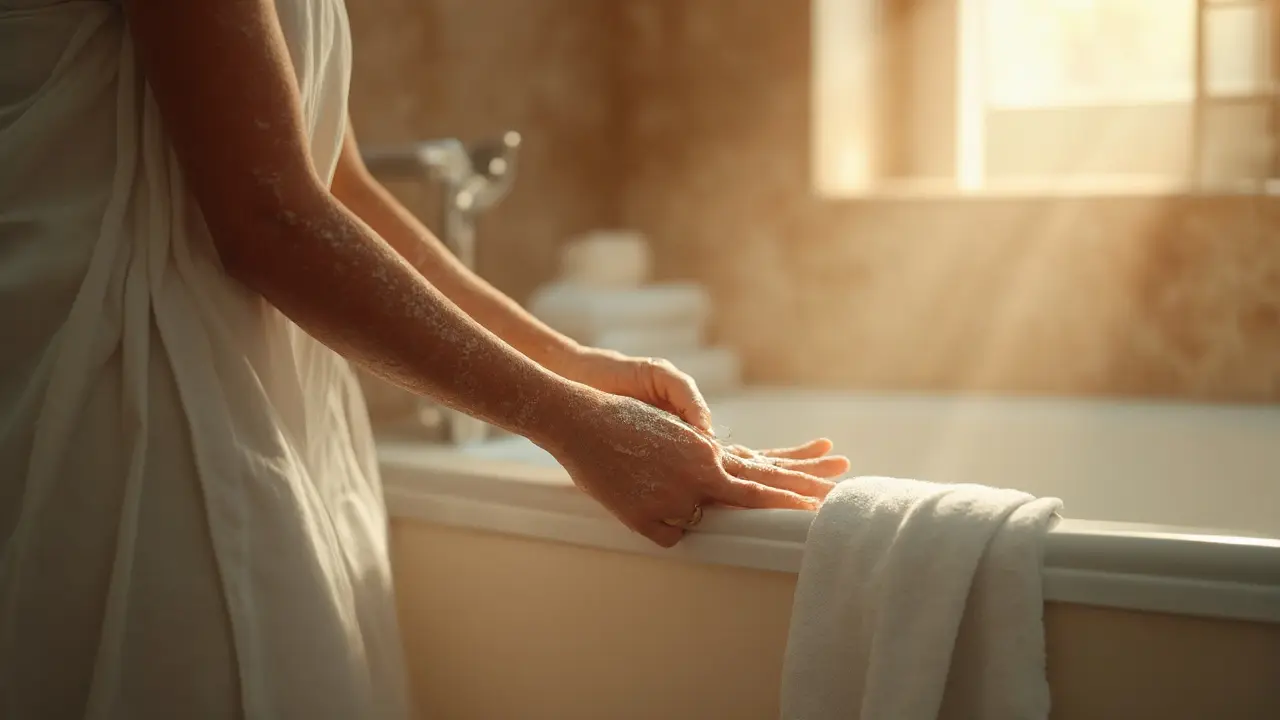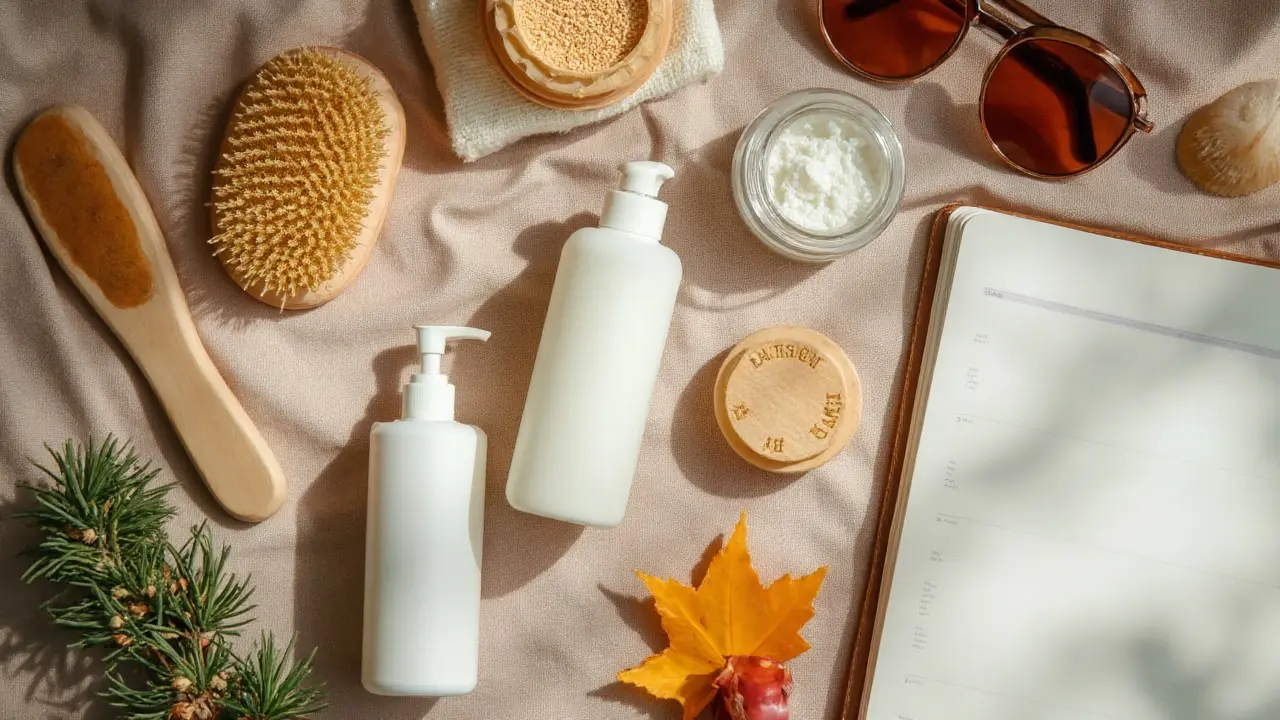You want smooth, glowier skin without the sting, flakes, or random breakouts that show up when you overdo it. The truth? There isn’t one magic number for everyone. Frequency depends on your skin type, the product you use (gritty scrub versus acids), the season, and how much you sweat. We’ll set a reliable baseline, then help you tweak it so your skin stays soft and calm.
TL;DR: The short answer
- how often should you scrub your body: For most people, 1-3 times per week is the sweet spot. Daily body scrubs are usually too harsh.
- Sensitive, dry, eczema-prone, or post-shave skin: Start at once every 10-14 days, or skip gritty scrubs and use a gentle chemical exfoliant.
- Oily or body-acne-prone: 2-3 times weekly, favoring a salicylic acid (0.5-2%) wash or a leave-on with lactic acid (5-12%) or urea (10-20%).
- Keratosis pilaris (KP): 2-3 times weekly combining a mild mitt plus lactic acid/urea lotion, then moisturize.
- Climate and lifestyle matter: Hot, sweaty months and heavy workouts can push you to 2-3x/week; cold, dry months usually mean dialing back to 1-2x/week.
- Red flags you’re over-exfoliating: stinging in the shower, tight/itchy skin, flaky patches, more breakouts. If that hits, pause actives, moisturize, and cut frequency in half.
Dermatology groups like the American Academy of Dermatology advise starting low (1-2 times weekly) and adjusting to tolerance. Your skin should feel soft and comfortable after, not squeaky, tight, or raw.
How to exfoliate your body safely (step-by-step)
Exfoliation means removing dead skin so the surface looks smoother and absorbs lotion better. You can go physical (scrubs, gloves, brushes) or chemical (acids and enzymes). Here’s the safest way to do it without wrecking your barrier.
Pick your method. If your skin is reactive or you have eczema/psoriasis, lean chemical and gentle. If you love the “scrub” feel, pick fine, rounded particles (sugar, jojoba beads) over jagged ones (crushed shells).
Patch test first. Try a small amount on your inner arm or side of the thigh for 24 hours. No rash or burning? You’re good to try a full session.
Prep the skin. Hop in a warm (not hot) shower for 3-5 minutes to soften skin. Hot water can strip your barrier and make exfoliants burn.
If you’re using a physical scrub or mitt: Use about a tablespoon for each leg and a teaspoon for each arm. Gently massage in small circles for 30-60 seconds per area. Think “polish,” not “sand.” Rinse well.
If you’re using a chemical exfoliant: For washes (like salicylic acid cleansers), lather, leave on 60-90 seconds, then rinse. For leave-on lotions (lactic, glycolic, urea), apply to clean, dry skin and let it absorb before layering moisturizer. Start every third night.
Shaving and self-tan timing. Don’t scrub right before or after shaving-space it by 24 hours to avoid razor burn. Exfoliate 24 hours before self-tanner for an even result.
Moisturize within 3 minutes. Lock in water immediately with a fragrance-free lotion or cream. Look for ceramides, glycerin, squalane, shea butter, or petrolatum. After acids, keep it simple-no heavy fragrances.
Sun protection. Freshly exfoliated skin can be a bit more sun-sensitive. If skin is exposed, use SPF 30+ the next day.
Quick sanity check after you towel off: does your skin feel comfortable? If it stings, throbs, or looks blotchy for more than 15 minutes, that session was too rough. Next time: lower pressure, shorter contact time, or switch to a gentler method.

Find your frequency: skin types, seasons, and lifestyle
Here’s how to set a routine you can stick to-and tweak when life, weather, and hormones change the vibes.
If your skin is sensitive or dry: Start with chemical exfoliants every 10-14 days. Try lactic acid 5-10% or urea 10-20% in a lotion. Skip gritty scrubs. If you have eczema or psoriasis, ask your dermatologist before starting any exfoliant and avoid scrubbing active patches.
If your skin is normal or combination: Try 1-2 times per week. One session can be a gentle scrub, the other a mild acid lotion. Keep water lukewarm and moisturize right after.
If your skin is oily or acne-prone (back, chest, butt): 2-3 times weekly. A salicylic acid (BHA) body wash 0.5-2% helps unclog pores. On alternate days, use a bland moisturizer. Avoid harsh scrubbing on active, inflamed breakouts-chemical is kinder here.
Keratosis pilaris (KP): Those tiny bumps on arms/thighs love lactic acid (5-12%) or urea (10-20%) most days and a very gentle mitt 1-2x/week. Always follow with a rich moisturizer.
After workouts and sweat-heavy days: Warm shower, mild body wash, then chemical exfoliant 2-3x/week if you get clogged pores or folliculitis. On other days, stick to gentle cleanse + moisturizer.
Seasonal tweaks: Winter air is dry, so reduce to 1-2 times weekly and add a thicker cream. In summer, when skin is oilier and sweaty, 2-3 times may be fine-watch your skin’s response.
Skin of color: Be cautious with aggressive scrubbing because it can trigger hyperpigmentation. Favor chemical exfoliants at conservative strengths, and keep physical pressure light.
50+ skin: The skin barrier is thinner and drier with age. Keep exfoliation gentle and less frequent (every 10-14 days), and double down on moisturizers with ceramides and cholesterol.
Want a ready-made weekly plan? Try these starting templates and adjust:
Dry/sensitive, office indoors (winter): Sunday: lactic acid 5-8% lotion at night; Wednesday: skip exfoliation, use thick cream; Other days: cleanse, moisturize. Reassess in 2 weeks.
Runner, humid climate, body-acne-prone: Mon/Wed/Fri: salicylic acid (0.5-2%) body wash after workouts; Sunday: fragrance-free cream only. If any sting/peel shows up, cut to Mon/Thu.
KP on arms/thighs: Tue/Sat: gentle exfoliating mitt for 30 seconds per area; nightly: urea 10-20% lotion on bumps. If too dry, drop mitt to once weekly.
Guideline anchor: The AAD and similar bodies advise starting at the low end, then titrating. If skin is happy for 2 weeks-no tightness, no sting-you can add a session. If it complains, you back off.
Tools and products: scrubs, acids, mitts-pros, cons, and when to use
Not all exfoliation is equal. Here’s how the common options stack up and how often to start using them.
| Method / Product | Best for | Start with | Strength notes | Common pitfalls |
|---|---|---|---|---|
| Sugar scrub (rounded particles) | Normal skin; pre-self-tan polish | 1x/week | Gentler than salt; melts with water | Over-scrubbing; fragrance irritation |
| Exfoliating mitt/glove | KP, ingrowns, body polishing | 1x/week | Control pressure; short sessions | Rubbing too hard; using daily |
| Dry brush | Light flake removal pre-shower | 1-2x/week | Use gentle strokes toward heart | Claims about lymph are unproven; can scratch |
| Pumice/foot file | Heels/calluses only | 1x/week | Feet only; soak first | Never on thin body skin |
| Salicylic acid body wash (0.5-2%) | Body acne, oily skin | 2-3x/week | BHA unclogs pores; short contact | Too drying if used daily for some |
| Lactic acid lotion (5-12%) | Dry, dull, KP-prone | Every 3rd night | Gentle AHA; hydrating | Sting on cuts; avoid right after shave |
| Glycolic acid lotion (5-10%) | Texture, rough patches | Every 3rd night | Stronger AHA; watch sensitivity | Can irritate sensitive skin |
| Urea lotion (10-20%) | KP, rough spots, dryness | Daily or every other day | Keratolytic + humectant | Higher % may sting broken skin |
| Enzyme body polish (papain/bromelain) | Sensitive types wanting no scrub feel | 1x/week | Mild exfoliation | Allergy risk (rare); check label |
Ingredient cheat sheet:
- AHA (lactic/glycolic): Surface smoothing. Start lower (lactic 5-10%, glycolic 5-8%).
- BHA (salicylic): Pore decongesting. Great for chest/back acne and ingrowns.
- Urea 10-20%: Softens and gently dissolves rough keratin plugs (especially good for KP).
Product safety tips:
- Avoid scrubs with jagged particles (crushed shells, salt on sensitive skin) and added fragrance if you’re reactive.
- Microbeads made of plastic are banned in many countries-choose biodegradable options.
- Don’t layer multiple strong actives on the same night (e.g., glycolic + retinoid + scrub)-pick one.
- If you’re on prescription topicals (like retinoids) or have a chronic skin condition, confirm with your dermatologist before adding exfoliants.

Checklist, mini‑FAQ, and next steps
Keep this handy so you don’t have to think about it in the shower.
Pre-scrub checklist:
- Skip on days you shaved or waxed within 24 hours.
- Avoid hot water-warm is enough.
- If you’re trying a new product, patch test first.
During:
- Use light pressure and short contact time (60-90 seconds for washes; 30-60 seconds per area for scrubs).
- Avoid open cuts, active rashes, and inflamed acne lesions.
- Rinse thoroughly-no gritty bits left behind.
After:
- Moisturize within 3 minutes with a simple, fragrance-free lotion or cream.
- Wear SPF 30+ on exposed skin the next day.
- Note how your skin feels at the 30-minute mark-comfy means you nailed it; sting/tight = too much.
Rules of thumb to set frequency:
- If your skin feels tight or stings after plain water the next day, reduce frequency or switch to a milder method.
- If you’re still feeling rough bumps after 2 weeks, add one more session or switch from physical to chemical.
- If you get more breakouts after scrubbing, drop the scrub and try a salicylic acid wash instead.
Mini‑FAQ
- Can I scrub daily? Most people shouldn’t. Daily body scrubs often damage the barrier. If you crave daily smoothing, use a mild urea lotion and limit scrubs to once weekly.
- Should I exfoliate before or after shaving? Exfoliate the day before. Shaving right after a strong exfoliation can burn.
- What about self-tanner? Exfoliate 24 hours before applying. After tanner, switch to gentle, non-exfoliating moisturizers to prolong the tan.
- Is chemical exfoliation safer than physical? For many, yes-especially if you’re acne-prone or sensitive. It’s more controlled. Start low and go slow.
- Pregnant or breastfeeding? Many AHA and urea body products are commonly used in pregnancy, while high-strength salicylic acid leave-ons may be avoided. Always check with your healthcare provider.
- Teen skin? Keep it simple. If there’s body acne, a low-strength salicylic wash a few times weekly can help. Avoid heavy scrubs.
- Dark spots or hyperpigmentation risk? Avoid harsh scrubbing and irritation, which can worsen pigment. Gentle chemical exfoliation at lower strengths is safer.
- Can I use an exfoliating glove every shower? No. Treat it like a scrub-once a week for most. Daily use is a fast track to irritation.
- How do I clean tools? Wash mitts and brushes with soap, rinse, and dry fully. Replace every 4-8 weeks to avoid bacteria and mildew.
Troubleshooting
- Signs you over-exfoliated: Burning or stinging with water, flaky patches, sudden sensitivity to products, or more breakouts. Action: stop exfoliants for 5-7 days, moisturize 2-3x/day with a bland cream. If very irritated, a short course of a gentle, over-the-counter hydrocortisone may help on small areas-confirm with a clinician first.
- Ingrown hairs: Switch to a BHA wash 2-3x/week and use a light lotion daily. Don’t dig at ingrowns-see a pro for severe cases.
- Body acne flare after scrubs: Scrubs can inflame follicles. Swap to salicylic acid and decrease frequency. Keep sweaty clothes off your skin-shower within 30 minutes of workouts.
- KP still rough after two weeks: Add nightly urea 10-20% and keep mitt use mild, once weekly. Be patient-KP responds, but slowly.
- Razor burn: Space shaving and exfoliation 24 hours apart. Use a creamy, fragrance-free shave medium and a sharp blade.
Next steps
- Pick one method (gentle scrub or low-dose acid) and start at the lowest frequency that seems right for your skin type.
- Run your plan for two weeks without changing three other things at once. Track comfort and results.
- Adjust: add or subtract one session weekly depending on how your skin feels, not just how it looks.
- If you have a chronic skin condition or persistent irritation, check in with a board‑certified dermatologist. The AAD and national dermatology colleges publish patient guides you can reference when you go.
Bottom line: think “polish, don’t punish.” Smooth skin comes from consistent, kind exfoliation plus diligent moisturizing-not scrubbing harder. When in doubt, scale back. Your skin will tell you what it likes.






September 10, 2025 AT 13:50
The government’s “dermatology” guidelines are a smokescreen for skin‑tracking nanotech.